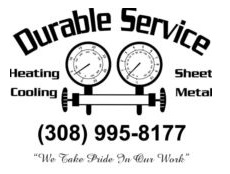
Ceiling fans are one of the most overlooked ways to make your home more comfortable and lower energy costs. By enhancing air circulation and supporting your HVAC system, ceiling fans and energy efficiency are truly a perfect combination. They offer a cost-effective, cost-saving way to keep cool while reducing strain on your AC—even preventing unnecessary air conditioning repair.
In this blog, the experts at Durable Service discuss how ceiling fans can improve your comfort while saving you money thanks to increased HVAC efficiency. We'll also offer some HVAC efficiency tips that put to good use ceiling fans.
Comfort vs. Temperature: Staying Cool Using the Wind-Chill Effect Indoors
Ceiling fans don’t actually cool the air—they make your home more comfortable by increasing air movement across your skin. This is called the wind-chill effect, and it can make a room feel up to 4 degrees cooler without touching the thermostat. That means you stay comfortable and enjoy the benefits of indoor air circulation from your ceiling fan while minimizing air conditioner use—helping reduce your electric bill in summer.
The Best of Both: Benefits of Using Fans and Air Conditioning Together
There are several upsides to using ceiling fans and air conditioning in tandem, especially during the warmer months. By combining both, you maximize HVAC efficiency and enjoy a cooler living space with less strain from your cooling system.
Benefits of using ceiling fans and AC together:
- Ceiling fans help lower HVAC load by circulating cool air more evenly around a room. Reducing HVAC stress is important, because it can save you from a breakdown that could lead to premature AC or furnace installation.
- Using ceiling fans boosts the comfort level of your home by getting rid of warm pockets and improving air movement.
- Running both ceiling fans and AC can lower your utility usage. If you have a home automation system, you can even adjust your smart thermostat settings to bump up the temp a few degrees while your ceiling fan is running.
Clockwise vs. Counterclockwise Ceiling Fan Rotation: Which Direction Should a Fan Spin?
To make full use of your ceiling fans year-round, it’s important to make sure the blades rotate in the right direction for the season. The direction influences how air moves, which can either cool you down or gently recirculate warm air so you feel warmer.
When to spin ceiling fans counterclockwise
In the summer, ceiling fans should spin counterclockwise at a quick speed. This creates a breeze that pushes cool air downward, enhancing the wind-chill effect and causing you to feel cooler.
When it's best to spin ceiling fans clockwise
In the winter, set your fan to rotate clockwise on a low speed. This gently pulls cool air upward and pushes warm air near the ceiling down toward you, helping you feel warmer without touching your thermostat.
How to Pick Out the Best Ceiling Fan for My Home
Picking the right ceiling fan depends on a few important details, including blade design, airflow rating and room dimensions. First, look for fans that have a good balance of ECFM airflow and blade pitch to provide efficient air movement in your home:
- ECFM is how much air a fan moves—the cubic feet per minute, or CFM—per watt of electricity used. Fans with higher ECFM are more energy efficient.
- Blade pitch refers to the angle of the blades. A steeper blade pitch moves more air than a shallower pitch but can also stress the fan’s motor.
Also, consider room size when sizing a ceiling fan—a fan that’s too small won’t move as much air as you'd like, while one that’s too big may be overpowering for the room.
Boost Your HVAC Efficiency With the Team from Durable Service
At Durable Service, our HVAC specialists can help you enjoy year-round comfort while minimizing wear on your heating and cooling systems. From practical fan advice and air conditioning installation to smart thermostats and furnace repair, we offer comprehensive services that work with your budget. Schedule your appointment by calling 308-995-8177 today.

